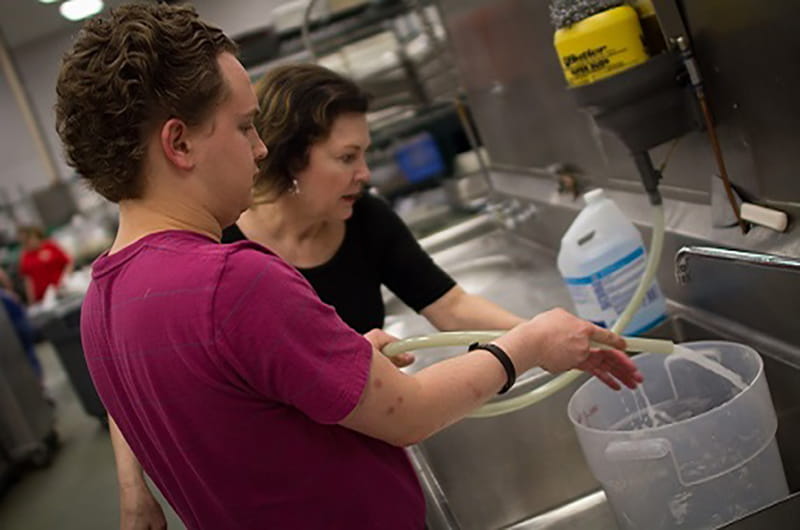For Youth with Autism, Where You Live Matters: Study of Vocational Rehabilitation Services Across States

- Drexel Selects New, World-Class Life Sciences Building at 3201 Cuthbert Street for Medical Research Operations
- Turn Happy Places and Memories into a Happy New Year
- Breakthrough on Gene Therapy for Hereditary Spastic Paraplegia
- Drexel Environmental Collaboratory Releases Cross-Sector Findings on Severe Weather Recovery Challenges

Youth with autism often have difficulty finding and keeping employment, making Vocational Rehabilitation (VR) services, like job placement, essential. New research from Drexel University's A.J. Drexel Autism Institute found Vocational Rehabilitation services across states vary dramatically leaving some young adults without support. Unemployment is a critical issue, especially for those with autism who have contributions to make but not enough opportunities for work.
The study, published in the Journal of Autism and Developmental Disorders, analyzed Vocational Rehabilitation data from the U.S. Department of Education to explore differences across states in how often youth with autism actually receive Vocational Rehabilitation services after being found eligible; how many begin these services as early as possible (during secondary school); how often youths' plans for employment services are established in a timely manner and the rate at which students achieve employment following these services.
Vocational Rehabilitation is a key source of public assistance for people with disabilities who are seeking employment. The program is paid for with a combination of federal and state funds, and is administered by state and territorial programs.
Individuals who are found eligible for Vocational Rehabilitation may receive services related to exploring possible careers, assistance locating jobs, and short- or long-term support in the workplace, among others. According the Rehabilitation Act, individuals are eligible for services if they have a disability with significant physical or mental impairment which results in substantial problems with employment and require services to prepare for, find, keep or regain employment.
"We found huge gaps across states. Nearly 90 percent of youth in Pennsylvania received VR services after they were found eligible, but only half of youth in neighboring New Jersey received services," said Anne Roux, a research scientist at the Autism Institute's Life Course Outcomes program, who led the research. "Employment specialists in every state know it is critical to connect students with autism to VR services as quickly as possible. Yet, only 10 percent of youth with autism in Montana began their VR services during high school, compared to 77 percent in Oklahoma."
The research team also found a gap of 60 percentage points across states in how often plans for employment were developed within the recommended federal timeline and a gap of 47 percentage points in how many youth with autism were employed when services ended - ranging from 29 percent in D.C. to 76 percent in the state of Washington.
"Over 51,000 transition-age youth with autism exited VR services in the 2014-2016 data we looked at- roughly, 19,000 per year. In some states, only one-third had a job at the end of VR services. So, we can see which states have significant needs for longer-term services to connect youth with employment or other activities," said Jessica Rast, a co-author of the study from the Autism Institute.
The researchers also uncovered encouraging news. At least 70 percent of youth with autism had jobs following services in four states: Alabama, Nebraska, South Dakota and Washington.
"Clearly, some states are finding ways to effectively provide VR services for youth with autism. Our next step is to learn what these higher performing states are doing differently than others," said Roux.
In the study, differences across states were not explained by differences in youth characteristics, state unemployment levels or state fiscal capacity to provide services, suggesting that differences in state disability policy and Vocational Rehabilitation practices might contribute to successes in some states.
"Ultimately, we want to understand how states are making decisions about delivery of employment services for youth with autism," said Paul Shattuck, PhD, Life Course Outcomes program leader and an associate professor at the Dornsife School of Public Health. "Reducing disconnections between leaving high school and entering work or postsecondary education - and staying on a positive course during the entry to adulthood - is vital for building better futures for youth on the autism spectrum."
"State-Level Variation in Vocational Rehabilitation Service Use and Related Outcomes Among Transition-Age Youth on the Autism Spectrum" was published in the Journal of Autism and Developmental Disorders and is the latest publication in a series of studies of Vocational Rehabilitation services by researchers at the Autism Institute. The team began its investigation of state Vocational Rehabilitation services in 2016 with the groundbreaking National Autism Indicators Report: Vocational Rehabilitation. More information about Vocational Rehabilitation is available in the 2016 report.
This project was supported by the Health Resources and Services Administration (HRSA) of the U.S. Department of Health and Human Services (HHS) under UJ2MC31073: Maternal and Child Health-Autism Transitions Research Project. This project was also supported by funding from the Organization for Autism Research (OAR), Inc. Applied Research Grant, under the title "Association of State-Level Factors with Vocational Outcomes for Transition-Age Youth with Autism."
Read the full study here.
Drexel News is produced by
University Marketing and Communications.